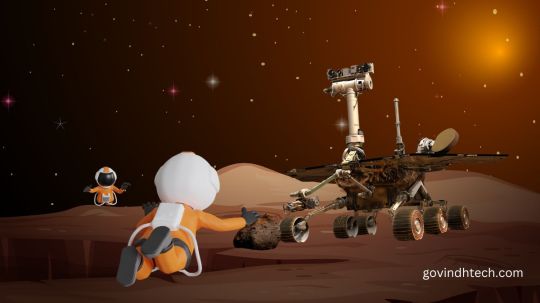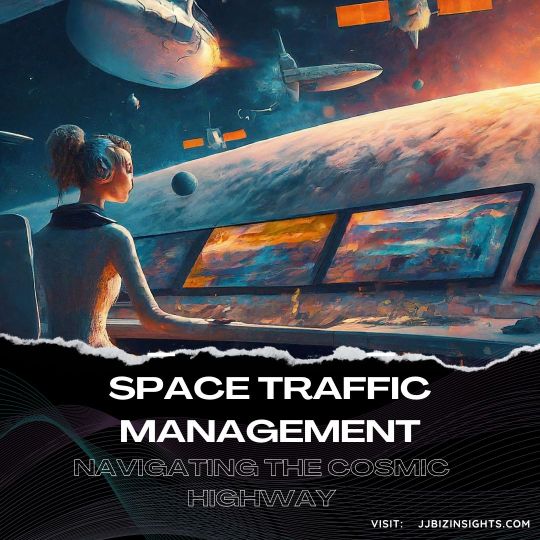#spacetechic
Text
Space Tech: Private Ventures and Mars Exploration

Space Tech
Beyond intrepid exploration, space technology has advanced to address pressing issues on Earth. It is becoming more and more essential to the effective operation of contemporary societies and their economic growth. Space has the potential to directly affect billions of people’s lives and open up large-scale, highly impactful solutions.
A broad term for satellites, space stations, ground stations, tracking and monitoring centers, downstream analytics and artificial intelligence, software, and other technologies, SpaceTech offers innovative ways to solve global concerns. Satellites increase communication, navigation, and earth observation capacity at low cost even in remote locations. Satellite-based earth observation data is vital, accurate, and reliable for data-driven decision-making by businesses and governments.
The underserved and otherwise unprofitable regions can benefit from high-speed connectivity thanks to the satellites. The application of action plans for intelligent agriculture, resource management (land and water), infrastructure development (urban and rural), climate and weather monitoring, environmental protection (including reducing the risk of disaster), and other purposes can all benefit from the use of satellite data.
Aerospace Innovation
The space industry is predicted to increase in value from USD 360 billion in 2018 to USD 558 billion by 2026 and roughly USD 1 trillion by 2040. Even though the Indian Space Research Organization (ISRO) is one of the world’s top space agencies and is working on projects like the Indian Regional Navigation Satellite System (NavIC) and the Mars Orbiter Mission (MOM), India currently only makes up 2%, or USD 7 Bn, of this market value.
One reason could be that the private sector’s contribution to the Indian space industry has primarily consisted of ISRO subcontracting, with ISRO historically handling the crucial value addition activities internally. Because of this, Indian private companies have lagged behind other world leaders in SpaceTech in terms of end-to-end capabilities.
The publication of SpaceCom Policy 2020, Space RS Policy 2020, Geospatial Policy 2021, and other policies, along with the creation of organizations like NewSpace India Ltd (NSIL) and the Indian National Space Promotion and Authorization Centre (IN–SPACe), have created a national push to expedite the private sector’s involvement in the Indian space area. The Department of Space is also working on a comprehensive Space Act and other policies, including launch vehicle and space exploration policies.
Because of our natural curiosity and desire to understand the universe, space travel has long fascinated people.
Recently, private enterprise and international cooperation have transformed space exploration.
This article will explore the changing face of space exploration and emphasize the importance of international collaboration and private industry.
New Space Technologies
Pioneers of Personal Space Travel
NASA, Roscosmos, and ESA were the only government space agencies allowed to explore space. However, private companies leading space innovation changed everything:
SpaceX since 2002 has resupplied the ISS, developed reusable rocket technology, and prepared to colonize Mars.
Jeff Bezos’ Blue Origin offers professional and recreational suborbital and orbital spaceflight.
Rick Branson’s suborbital space tourism company, Virgin Galactic.
Innovating, competing, and seeking commercial opportunities beyond Earth are redefining space exploration in private space ventures.
Space Exploration Companies
International Space Cooperation
Space exploration requires international cooperation even as private businesses grow:
The Earth-orbiting International Space Station (ISS) is a global collaboration marvel. European, Japanese, Canadian, Russian, and US space agencies participate.
Mars exploration: NASA, ESA, and others work on Curiosity and Mars Sample Return.
The Artemis Accords outlines global cooperation on the Moon and beyond, inviting international partners to lunar exploration.
Global Collaboration and Private Enterprises Benefits
Space exploration benefits from private sector involvement and international cooperation in a number of ways.
Innovation: By bringing in competition and innovation, private endeavors lower costs and advance technology.
Commercialization: Businesses worldwide can take advantage of commercial endeavors to expand their satellite deployment, space tourism, and resource exploitation capabilities.
Shared Resources: Working together, nations can pool resources, exchange knowledge, and take on challenging projects.
Scientific Discovery: Across national boundaries, international cooperation increases the possibility of scientific discovery and exploration.
Difficulties and Things to Think About
Although private and international partnerships present notable benefits, they also present certain challenges.
Regulation: To address new challenges, the framework governing international cooperation and private space endeavors needs to change.
Resource Management: A complex ethical and legal challenge is the responsible use of space resources, such as lunar mining.
Space Debris: Coordinated actions ought to tackle the expanding problem of space debris and environmentally friendly space operations.
Space Travel Prospects
Future space exploration could lead to asteroid mining, planet colonization, and scientific breakthroughs.
Space exploration is entering a new era as private companies and multinational partnerships change the space environment.
Space exploration is more accessible, sustainable, and transformative than ever thanks to private innovation and international collaboration. It shows our willingness to push the limits and our enduring spirit of exploration.
Mars Rover
What is Mars Rover?
A robotic vehicle that investigates the surface of Mars is called a rover. Rovers are long-range, remotely controlled vehicles that gather data and take images while traveling great distances. They have found evidence of water, ancient life, and possible resources on Mars, among many other significant discoveries.
Six Mars rovers have been successful so far:
In 1997, Sojourner became the first rover to set foot on Mars. During 83 days, it investigated the Ares Vallis region.
The twin rovers Spirit (2004) and Opportunity (2004) touched down on Mars in 2004. For many years, they investigated the Gusev Crater and Meridiani Planum, respectively. Opportunity stopped operating in 2018 and Spirit became stuck in 2010.
Gale Crater is presently being explored by Curiosity (2012). It has found evidence of ancient lakes and rivers, among many other significant discoveries.
The Jezero Crater region is being explored in Perseverance (2021). In addition to gathering samples of rock and regolith broken rock and soil for potential return to Earth, it is searching for indications of prehistoric life.
The first Chinese rover to set foot on Mars is Zhurong (2021). It is investigating the area of Utopia Planitia.
An essential component of our Mars exploration are the Mars rovers. They have made significant contributions to our understanding of the Red Planet’s potential for habitability.
Read more on Govindhtech.com
#Space Tech#MarsExploration#Ventures#SpaceTech#satellites#AI#Aerospace#NASA#technews#technology#govindhtech
2 notes
·
View notes
Text

Exploring the ever-evolving realm of the LEO Satellite Mega Constellations Market!
Get a FREE Sample: https://www.nextmsc.com/leo-satellite-mega-constellations-market/request-sample
From SpaceX's Starlink to OneWeb's network, these constellations are revolutionizing global connectivity. As demand for high-speed internet and data transmission grows, these constellations promise unparalleled coverage and reliability.
Stay tuned as we delve into the dynamics shaping this transformative market!
0 notes
Video
youtube
Space Tech for Weighing Trees | Nature IS | Episode 102 with Florian Reber
#youtube#spacetech#nature#florianreber#space tech#weigh trees#climate change#carbon storage#forestry#remote sensing#geospatial technology#sustainability#net-zero#nature is
0 notes
Text
Space Traffic Management: It's Not Just Rocket Science, It's Rocket Traffic Control! ️ #SpaceExploration #Cosmos

#SpaceTrafficManagement#STM#SpaceTech#SpaceExploration#Cosmos#SpaceDebris#Sustainability#CollisionAvoidance#OrbitalMechanics#FutureOfSpace#Innovation#Science#Technology#SpaceNews#SpacePolicy
0 notes
Text
The Starship and the D.O.D.
I have commented to use the Starship to reach the other side of the planet in an hour and drop down to Sub Orbit to circle military bases. The Starship is still 100 miles high and out of the range of any ground defenses, but not to drop a nuclear bomb.
This video shares some other useful things to do with the SpaceX Starship?
The Starship aims for the bases and drops Titanium Canon Balls that…

View On WordPress
0 notes
Text
youtube
Space Operations Command's newest Delta, Space Delta 18, was activated and the National Space Intelligence Center (NSIC) was established during a ceremony at the Nutter Center, Dayton, Ohio
#youtube#SpaceDelta18#NSIC#SpaceOperations#UnveilingSpace#FrontiersOfSpace#SpaceExploration#SpaceTech#SpaceMission#SpaceTravel#SpaceInnovation#SpaceScience#SpaceEngineering#SpaceTechnology#Aerospace#Astrophysics#RocketScience#SpaceResearch#SpaceMissions#SpaceProgram#SpaceAdventures
0 notes
Text
🚀 What If We Nuked Mars? 🌌
Have you ever wondered what would happen if we unleashed the power of nuclear weapons on the Red Planet, Mars? 💥🔴
Mars has always been a subject of fascination for astronomers, scientists, and space enthusiasts alike. It's often the topic of discussions regarding colonization, terraforming, and the search for extraterrestrial life. But what if we considered a more radical approach to altering the Martian landscape?
🛸 Exploring the Hypothetical Scenario 🤔
In this imaginative journey, we'll delve into the idea of "nuking" Mars, exploring the potential consequences, challenges, and the ethical implications of such an audacious endeavor.
🌌 The Martian Challenge 🪐
Mars, with its thin atmosphere, frigid temperatures, and lack of liquid water, presents significant challenges for human colonization. The idea of nuking Mars has been proposed as a way to kickstart its transformation into a more hospitable world. But would it work, and what would be the repercussions?
🌋 Triggering Terraforming 🔥
One proposed idea is to detonate nuclear bombs on Mars' polar ice caps. The intense heat generated by the explosions could potentially release vast amounts of water vapor and carbon dioxide, enhancing the planet's atmosphere and potentially creating conditions conducive to life.
🌡️ Climate Change on Mars 🌬️
Nuking Mars would cause a substantial rise in temperature, which could, over time, melt the polar ice and create liquid water reservoirs. However, this process would take centuries, if not millennia, and require countless nuclear detonations.
🚀 The Ethical Dilemma 🤷♂️
The idea of deliberately altering another planet raises profound ethical questions. Should we be tampering with the natural evolution of celestial bodies? What about the potential risks to future missions or unforeseen consequences?
🪐 A Risky Proposition 🌠
Nuclear explosions on Mars could release radioactive fallout, contaminate the planet's surface, and pose risks to future missions. Additionally, the long-term effects on the Martian environment are uncertain, making this a high-stakes gamble.
🌌 Martian Evolution 🌱
Mars, over billions of years, has developed its own unique geology and potentially a hidden history of life. Nuking the planet could obliterate valuable scientific clues about the past and potentially jeopardize any existing microbial life.

🛠️ Technological Hurdles 🧪
Apart from the ethical and environmental concerns, there are immense technological challenges associated with nuking Mars. The logistics of transporting nuclear payloads, ensuring accurate detonations, and guaranteeing the safety of Earth and Mars are complex.
🔭 Alternatives to Nuking 🌿
Before we embark on such a radical course of action, there are alternative methods to consider for terraforming Mars. These include the use of greenhouse gases, orbital mirrors, and other technologies that could gradually transform the planet without the risks associated with nuclear explosions.
🌌 The Future of Mars Exploration 🌠
As humanity's interest in Mars continues to grow, discussions around its future intensify. Space agencies, private companies, and international collaborations are actively working on missions that may one day pave the way for sustainable Martian exploration.
🔥 Conclusion: Exploring the Unthinkable 🚀
The idea of nuking Mars remains a provocative and highly controversial concept. While it may offer a radical solution to making the Red Planet more Earth-like, the ethical, environmental, and technological challenges cannot be overlooked.
Let's keep exploring Mars, but perhaps with a more cautious approach, respecting the planet's natural evolution and the potential for scientific discoveries that await us.
#MarsExploration#TerraformingMars#NukingMars#SpaceEthics#MarsColonization#SpaceTech#PlanetaryScience#SpaceExploration#MarsMission#RedPlanet#MarsFuture#SpaceDilemma#ExtraterrestrialLife#MarsSurface#CelestialBodies#SpaceInnovation#MarsTerraforming#SpaceControversy#FutureInSpace#ExploringTheUnknown
0 notes
Text
The Tech and Science Behind Commercial Space Travel
Read our blog at
#SpaceTech#CommercialSpaceTravel#TechInSpace#SpaceScience#SpaceExploration#TechAdvancements#SpaceInnovation#CommercialSpaceflight#weblozy
0 notes
Link
https://bit.ly/3R5WXpM - 🤖 Pentagon's AI and Lethal Autonomous Weapons: The U.S. military is increasingly integrating artificial intelligence (AI) in warfare, revolutionizing traditional combat methods. AI is currently used for surveillance, maintenance prediction, and space monitoring. The Pentagon's 'Replicator' initiative aims to deploy thousands of AI-enabled autonomous vehicles by 2026, challenging traditional military innovation approaches and accelerating the deployment of AI in weaponized systems. #MilitaryAI #PentagonInnovation 🌏 Global Impact and Ethical Considerations: There is a consensus among experts that the U.S. will soon have fully autonomous lethal weapons. However, the ethical implications and control mechanisms of such systems are under debate. With advances in technology, human roles may shift to supervisory positions, raising concerns about the responsible use of military AI, especially in drone swarms. #EthicalAI #AutonomousWeapons 🚀 AI in Space and Fleet Maintenance: In space, AI tools like Machina autonomously monitor objects and potential threats. On Earth, AI assists the Air Force in predictive maintenance of aircraft. These applications highlight AI's growing role in maintaining military readiness and capabilities. #SpaceTech #AIPredictiveMaintenance 🔍 Challenges in AI Adoption and Development: The Pentagon faces significant challenges in adopting and developing AI technologies, with over 800 AI-related projects still in testing. The focus remains on augmenting human capabilities and understanding complex scenarios, rather than fully autonomous operations. #AIDevelopmentChallenges #PentagonAIProjects 🛰️ AI's Role in Ukraine and Battle Network Integration: AI technologies are crucial in supporting Ukraine against Russian aggression and in organizing logistics for military assistance. The Pentagon is also developing integrated battle networks for more efficient data processing across armed services, a project known as Joint All-Domain Command and Control. #AIinUkraine #IntegratedBattleNetworks 🤝 Human-Machine Teaming and Future Developments: The U.S. military emphasizes human-machine teaming, with several projects underway to integrate autonomous vehicles in combat scenarios. This includes the Air Force's "loyal wingman" program, which pairs piloted aircraft with autonomous drones. #HumanMachineTeaming #FutureOfCombat 🔬 Talent and Testing Challenges in Military AI: The Pentagon grapples with recruiting and retaining AI talent and establishing robust testing and evaluation standards. The challenge is to balance rapid AI deployment with rigorous testing to ensure reliability and ethical use in military contexts.
#MilitaryAI#PentagonInnovation#EthicalAI#AutonomousWeapons#SpaceTech#AIPredictiveMaintenance#AIDevelopmentChallenges#PentagonAIProjects#AIinUkraine#IntegratedBattleNetworks#HumanMachineTeaming#FutureOfCombat#AITalentChallenge#AITestingStandards#PentagonAI#LethalAutonomousWeapons#MilitaryTechnology#AIInWarfare#CyberDefense
1 note
·
View note
Text
Aerospace market research involves the system, andatic gathering, analysis interpretation of data related to the aerospace industry. It encompasses studying market trends, technological advancements, consumer preferences, regulatory factors, and competitive landscapes within sectors like commercial aviation, defense, space exploration, and emerging aerospace domains.
#Aerospace Market Research#Aerospace Market Reports#Aerospace Industry#Aircraft and Drones market Research#Spacetech Industry#Spacetech Market Research
0 notes
Video
youtube
Powering the Moon: Rolls-Royce's Lunar Nuclear Reactor Project
#youtube#MoonEnergy LunarExploration RollsRoyceSpace NuclearPower SpaceTech FutureOfSpace CleanEnergy SpaceInnovation SustainableSpace MoonBase
0 notes
Text
Space-Based Solar Energy Markets: Rising to New Heights
The global space-based solar power market size is expected to reach USD 1,053.8 million by 2030. The market is expanding due to increased investment in sustainable power generation and the adoption of rigorous government rules against pollution. On the contrary, R&D aimed at lowering the cost of solar space missions through improved technologies is expected to offer attractive growth prospects for key players in the global industry during the forecast period. For instance, in December 2021, Northrop Grumman, an American multinational aerospace and defense technology company, partnered with the Air Force Research Laboratory (AFRL) to develop and test hardware for space-based solar power experiments. Researchers and engineers intend to refine the technology and address potential challenges or limitations by conducting these tests and experiments.

Space-based Solar Power Market Report Highlights
The microwave-transmitting solar satellite segment held the largest revenue share of over 70% in 2022
This satellite generates solar power at a high level of efficiency and with minimal disturbance making it an attractive alternative for space-based solar power projects
The electricity generation segment led the market in 2022 accounting for over 74% share of the global revenue
The high share was attributed to a rise in energy demand and the cleaner generation of electricity globally
North America dominated the market in 2022, accounting for over 41% share of the global revenue owing to increased investments in R&D activities by government organizations, such as NASA, and private organizations’ participation in this region
Gain deeper insights on the market and receive your free copy with TOC now @: Space-based Solar Power Market Report
The increase in energy demand globally and a rise in awareness about reliable and sustainable energy sources are major factors driving the growth of the global industry. Moreover, space-based solar power could significantly mitigate climate change's effects by reducing greenhouse gas (GHG) emissions from traditional power sources. This is likely to fuel market growth over the forecast period. Furthermore, a rise in the application of space-based solar power in the military sector contributes to market growth. Moreover, space-based solar power systems can generate power continuously since they are not affected by factors like weather conditions or daylight limitations. They also help reduce GHG emissions and dependence on fossil fuels for energy generation. These systems can provide a source of energy to remote areas that are difficult to access with traditional energy infrastructure, such as developing countries or disaster-stricken areas. Thus, increasing their application scope in several end-use industries.
#Space Solar Power#Renewable Energy#SpaceTech#Clean Energy#Solar Power#Energy Revolution#Space Economics#Sustainable Energy#Solar Satellites#GreenTech#Energy Security#Future Energy#Space Infrastructure#Climate Change#Global Power Generation#Energy Transition#Space Based Technology
0 notes
Text
Second Attempt From Relativity Space!
The journey to space is never easy, and the Relativity Space team knows this all too well. 😔🚀 Despite their best efforts, the second attempt at launching their 3D-printed rocket was scrubbed on Saturday due to a "technical challenge." But setbacks are just opportunities for growth, and we're confident that the team will regroup and try again soon. We're rooting for you, Relativity Space!
0 notes
Text
Starship Struggles: Will SpaceX's August Launch Dream Take Flight?
#SpaceX#StarshipLaunch#SpaceExploration#ElonMusk#SpaceJourney#RocketLaunch#SpaceInnovation#SpaceDreams#SpaceAdventures#FutureOfSpace#ExplorationGoals#SpaceMission#Spacecraft#SpaceTravel#SpaceTech#SpaceFlight#SpaceXStarship#SpaceNews#Astronomy#IntoTheStars
0 notes
Text
Truth is an Accident waiting to happen?
I thought that The Angry Astronaut’s viewers would like to view this hour and a half ‘fiction’ presentation of how the U.S. Government has or has not kept track of the UAP ‘conspiracy’ Phenomenon. Here is what you get, ‘From me thinking?’.
https://tubitv.com/movies/100001911/accidental-truth-ufo-revelations
The Angry Astronaut is telling us about a small Lunar Outpost made by ASI and the rest…

View On WordPress
0 notes
Photo

Current Affairs | 09-12-2022 | L2A
1) It is kind of public-private collaboration for start-ups and SMEs in the space industry, this novel partnership is a significant step towards in providing further stimulus to India’s recent space reform policies and will work towards identifying and unleashing the market potential of the most promising space technology innovators and entrepreneurs in India.
2) SpIN will primarily focus on facilitating space tech entrepreneurs in 3 - distinct innovation categories:
1. Geospatial Technologies & Downstream Applications
2. Enabling Technologies for Space and Mobility
3. Aerospace Materials, Sensors, and Avionics
3) Innovative technologies in space field are expected to bring paradigm shift in utilising the space applications to maximise the economical growth, social and environmental benefits for the larger society in a country.
4) According to the Economic Survey Report 21-22, there are now over 100 active space start-ups in India, the number of start-ups in this space sector has more than doubled in the last year itself.
5) Through this partnership, ISRO will support the creation of an open innovation and scale-up platform for all space ecosystem stakeholders and promote active collaboration towards make early-stage space start-ups successful.
6) This also denotes the entry of Social Alpha in the area of space tech, a vertical that has the potential to grow manifolds and introduce innovations that can directly impact a millions of lives and livelihoods in a country.
7) Space science and the technology and data have highly potential to contribute to various Sustainable Development Goals with high-impact applications in ensuring the food security, reducing disaster risks and high management, preventing a humanitarian crises, and monitoring a natural resources.
#currentaffairs#currentaffairs2022#currentaffairsquiz#l2a#learn2achieve#IAS#upsc#upscpreparation#upscmotivation#upsccoaching#explore#explorepage#spacetech#spacetechnology#ISRO
0 notes